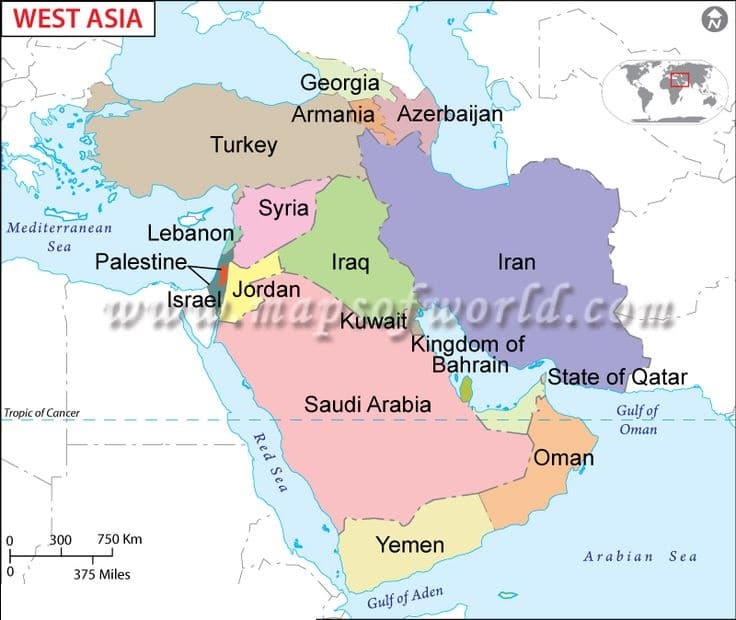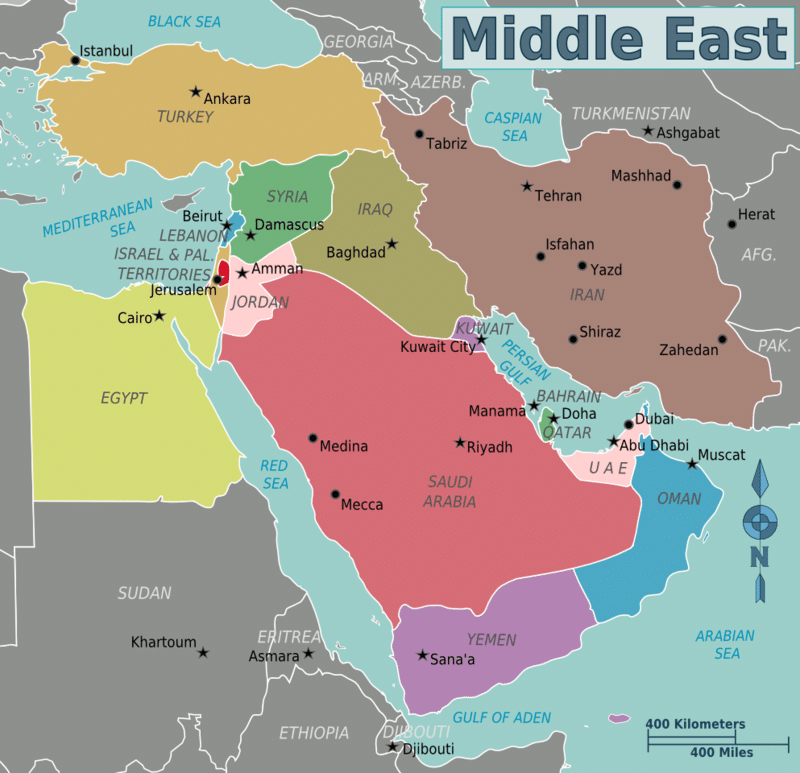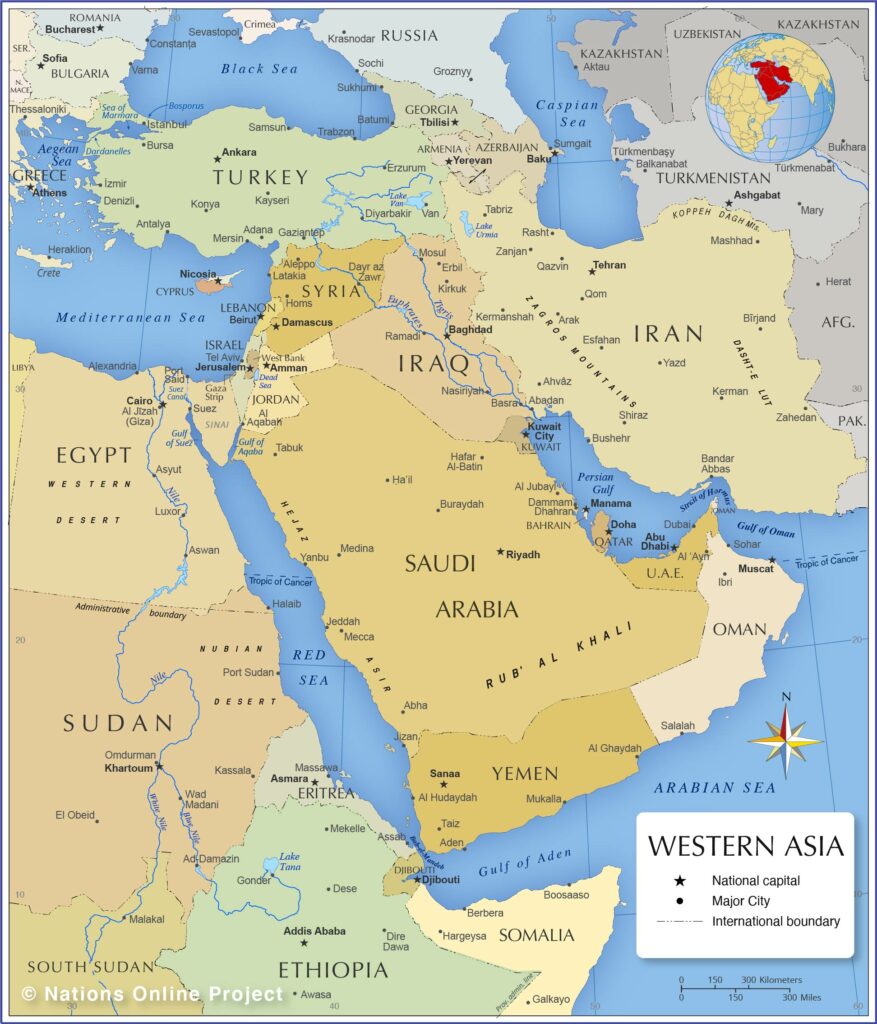West Asia is a land bridge which links three continents Asia, Africa and Europe. It is called the gateway of Asia-Africa and the back-door of Europe.
West Asia landmass meets three seas – the Mediterranean, Red and the Arabian Sea. It is a centre of international trade with different regions. The two most important waterways of the world, viz. the straits of Bosphorus and Dardanelles are also located here.
The discovery of oil in this region has immensely increased its importance. Strategic considerations have led the world powers to intervene in this region.
Historically, India’s West Asia policy has been multidirectional. During the Cold War years, India maintained close economic cooperation with both Saudi Arabia and Iran, the rival poles in regional geopolitics. Even when India warmed up to Israel in the 1990s as part of the country’s efforts to diversify its diplomatic engagement in the post-Soviet world, it was careful not to jeopardise the traditional relations with Muslim countries. The bi-directional approach has been expanded to a tri-directional foreign policy to accommodate the three key pillars of West Asia – Saudi Arabia, Iran and Israel.
The Arabs acted as a conduit to the West taking Indian knowledge like numerals and traded Spices, foodstuffs jewellery, textiles and muslin and other goods flowed from India toward the Arab region, while pearls and dates were exported from the Gulf region.

Evolution of India’s West Asia Policy
Historically, the relationship between the subcontinent and the Gulf goes back to ancient days. Britain controlled the Gulf littoral tightly because of its overwhelming strategic importance for the defence of India, the brightest jewel in the crown. The region has more to it than just being a centre of Israel-Arab confrontation. The geographical extent of what was West Asia has greatly expanded since the collapse of the USSR and is now called the “Greater Middle East”. This region shares a long historical association with India. It is the source for India’s ever-expanding needs of energy. It is also huge markets for Indian goods, services and skilled manpower.
Historically, India’s West Asia policy has been multi-directional. During the Cold War years, India maintained close economic cooperation with both Saudi Arabia and Iran, the rival poles in regional geopolitics. However, the bilateral relations were much below their potential.
Post-1991, extraordinary transformation of India’s relations with the region was witnessed. P.V. Narasimha
Rao, who assumed office in June 1991, swiftly wrought dramatic economic and foreign policy changes to
adjust to the new global geopolitical realities. Ideology, a protectionist economy, and advocacy of Third World concerns were junked; national interest-oriented pragmatism became the overriding guiding principle. India ceased viewing West Asia through the prism of its issues with Pakistan, discontinued the use of strong rhetoric denouncing other countries’ policies, and abandoned defensive, reactive policy approaches. India also started consciously courting the United States, now the lone global superpower. Importantly, India began to reach out to all West Asian countries without picking and choosing between them, and on the basis of mutual benefit.
After personally obtaining P.L.O. Chairman Arafat’s full concurrence, Narasimha Rao established full diplomatic relations with Israel in January 1992, disregarding extremely strong domestic criticism. The
relationship has flourished since then. At the same time, India was careful not to jeopardise the traditional
relations with Muslim countries. The bi-directional approach has been expanded to a tri-directional foreign policy to accommodate the three key pillars of West Asia — Saudi Arabia, Iran and Israel. In December 1992, Rao reached out to Iran; his visit the next year turned out to be exceedingly satisfying. A growing convergence of Indian and Iranian strategic interests in Afghanistan during the 1990s laid the foundation for a broad-based and mutually advantageous bilateral relationship in the future.
As the world welcomed India’s rise in contrast with growing anxieties about China’s rise, Saudi Arabia and
its Gulf allies began to look at India very differently.
India-West Asia relations are increasingly more intense and wide-ranging in scope and dimension. This is
apparent from the number of recent top-level visits exchanged between their leaders. Strategic dimension is increasingly seen in India’s engagements, with one of them being the formalisation of base facilities being provided to the Indian Navy by Oman at its Duqm port.
That India has managed to keep all of these diverse relationships on a positive track in spite of the political obstacles has not been easy. Since the turmoil in West Asia gathered force in 2011, India has hewed to a “hands-off” policy based on the principle that regime change through foreign intervention constitutes a violation of international norms and law. India has assiduously avoided taking sides in any of the region’s rivalries or conflicts. At the same time, India has supported all efforts to defeat the barbarous Islamic State as well as U.N. diplomatic initiatives aimed at the negotiated settlement of conflicts.
For decades, India was a passive player in West Asia — a beneficiary of good relationships with multiple actors. However, India would not prefer to sit on the margins at a time when China is raising its profile in West Asia. As its stakes in the region grow by the day, India needs to devote ever great amounts of diplomatic and political energies to deal with the unfolding changes in the Middle East.

Significance of ‘Look West’ Policy
After successfully implementing a “Look East” policy to promote trade and investment with its Asian neighbours, India has adopted a similar policy toward West Asia.
Adoption of the Look West policy in 2005 reflects India’s desire for engagement with its West Asian neighbours. Bilateral engagements have been extended to include threats of terrorism and piracy.
India’s endeavours for deeper engagement with the region has been well accepted by the Gulf countries that realise India’s potential as a large, stable, democratic country, and an emerging political and economic power in Asia and the world. West Asia forms a part of India’s extended neighbourhood.
Advantages of the ‘Look-West’ Policy
- A constructive and dauntless “look-west” policy from India would acknowledge the geopolitical significance of Pakistan.
- Rather than being an obstacle, Pakistan could become a link between the Indian subcontinent and the energy-rich region.
- Pakistan could also act as a transit route for the movement of people, goods and energy between India and the West Asian region.
- Pakistan has begun to move the self-perception of its location from geopolitics to geo-economics.
- More importantly, Pakistan’s ‘Look East’ Policy had developed considerably as evident from its admission into the security arm of the ASEAN.
- India will gain overland access to Iran, Afghanistan and Central Asia. Currently, India has to circumnavigate Pakistan and get access to Afghanistan through Iran.
- The essence of this policy was that an India-Pakistan reconciliation would be meaningful because it would increase the potential for regional economic integration in the subcontinent and also trans-regional cooperation between countries in Central Asia, South Asia and the Gulf.
- Resolving the Kashmir issue is vital for unleashing the geo-economic potential of the region. Pakistan itself has delinked its Kashmir issue with India and the construction of pipelines overland from Iran and Central Asia to India.
- The building of pipelines across Pakistan’s territory would also make it easy to construct highways linking India with Afghanistan and Iran.
- India could offer to negotiate trade and transit treaties involving all the 4 nations.
- India could also suggest cooperation with Pakistan in encouraging free trade between South Asia and the Gulf Cooperation Council. Any permanent resolution of the Kashmir issue would inevitably involve creative political cooperation across the divided state. It would also necessitate the complete normalization of Indo-Pak relations.
- Projects like interconnected electricity grids, natural gas pipelines, and transnational highway roads will realise the new strategic conception of Pakistan as India’s gateway to the West. India, in turn, will be Pakistan’s gateway to the East.
India’s Priorities in the Gulf
- Energy Security: The region supplies nearly 60% of India’s total crude oil requirement in which Saudi Arabia is top supplier. The region also accounts for major fraction of India’s LNG import.
- Trade and Investment: The Gulf remains a favourite trading partner for India and the trade figures have been consistently going up especially with countries like the UAE, Saudi Arabia and Iran. Attracting Foreign Direct Investment from the cash rich Gulf region is also a priority for India.
- Palestine Issue: India has maintained its stand on the “two-state” solution between Israel and Palestine and has reiterated its support for all efforts for a resolution, including on the contentious issue of Jerusalem, which Israel has claimed in its entirety since 1967.
- Forging Strategic Ties: The support of Gulf countries is important for India’s bid for Permanent Seat at UNSC. India and UAE have elevated the relationship to Strategic Partnership.
- Protecting Interests of Diaspora: Protecting the interests of the 9 million strong Indian diaspora has been an important element of India’s policy priorities in the Gulf . The Indian diaspora in the Gulf is a major source of remittances. The Reserve Bank of India estimates that for the period of 2006-07 to 2009-10, the Gulf region accounted for an average of 27 per cent of the total remittance inflows to India. The UAE and Saudi Arabia are the major source countries for the remittance.
- Military Cooperation: The growing threats of Islamic fundamentalism and terrorism have become concerns for both India and the Gulf countries.
- India has been deepening defence cooperation with countries like United Arab Emirates, Oman.
- India and Oman conduct regular bilateral exercises between their forces and Oman also provides refuelling facility to Indian ships and aircraft.
- India recently has secured access to key strategic Port of Duqm in Oman in Arabian Sea for military use and logistical support. It will further expand India’s footprint in the Indian Ocean region (IOR).
- This will strengthen India’s maritime strategy to counter Chinese influence and activities in the region.
- India and the United Arab Emirates have agreed to deepen their defence cooperation in a range of areas including military-to-military exchanges, training of personnel and defence production.
- Fighting Piracy: Piracy activities off the Gulf of Aden in the Indian Ocean have affected both India and the Gulf countries. For India, the security of the Indian Ocean is important for trade and energy security. Cooperation with the Gulf countries in fighting piracy would strengthen India’s presence in the strategic waters of the Indian Ocean.
- Strengthening Soft Power: In West Asia, India’s most distinct soft power asset is the diaspora and its role in buttressing a positive image of the country. Indian workers are often known for being peaceable, tolerant, and willing to work hard under harsh conditions. India’s policy of non-interference and neutrality are other dimensions of soft power. International Yoga was also celebrated in West Asian countries like UAE.
Challenges
- Political Instability:
- The security situation in West Asia has been continuously deteriorating ever since the onset of the Arab Spring in December 2010.
- The internal security situation in Syria, Iraq and Yemen has gone from bad to worse. The regional powers continue to fight proxy wars on sectarian lines, pumping huge amount of money and weapons to bolster their favoured groups.
- The involvement of extra-regional players such as the USA and Russia in the internal conflicts in West Asia (Syria )has further aggravated the situation.
- Terrorism:
- Terrorism has emerged as the biggest security threat in the region. The rise of the Islamic State and other terror groups has created threat to the Indian diaspora residing in West Asia.
- Also radicalization of Indian youth and they joining Islamic State has been another major problem
- Saudi–Iran–Israel rivalry:
- The rivalry has been destabilizing West Asia and influencing West Asian geopolitics. The recent withdrawal of US from JCPOA can be seen through the prism of this rivalry.
- It will be a difficult task for India to continue to balance its relations with all three countries without antagonizing any of them
- India– Israel close ties:
- India’s deepening defence and strategic relations with Israel has not gone down well with
- Iran,which has started to play its China and Pakistan card to extract more from India.
- China factor:
- China has made rapid inroads in the Gulf by having acquired equity stakes in the region’s upstream oil and gas sector and having successfully penetrated Arab markets.
- China is continuously making in road to west Asia through OBOR initiative.
- India’s incapacity to manage its own periphery, South Asia, has made Gulf Arabs more inclined to seek China as a better security partner, rather than India.
- China has made rapid inroads in the Gulf by having acquired equity stakes in the region’s upstream oil and gas sector and having successfully penetrated Arab markets.
- Pakistan factor:
- India’s “trust deficit” with Pakistan has incapacitated India from advancing its commercial interests in West Asia, including the bringing to fruition of the Iran-India-Pakistan (IPI) and Turkmenistan-Afghanistan-Pakistan-India (TAPI) gas pipeline projects.
- Arab slowdown & Nationalization:
- The decline of oil and gas prices, along with the rising cost of “war conditions” has led to the slowing of Arab Gulf economies, resulting in salary cuts, layoffs, contracting employment opportunities, and nationalization of workforces at the cost of Indian expatriate community.
- US Sanctions on Iran: US withdrawal from Iran nuclear deal and has threatened to impose economic sanctions on Iran. This may weaken the dialogue mechanisms, embolden conservatives, and may threaten regional stability even more.
- India also has significant oil trade with Iran and stakes in connectivity through Chabahar port and other projects.

